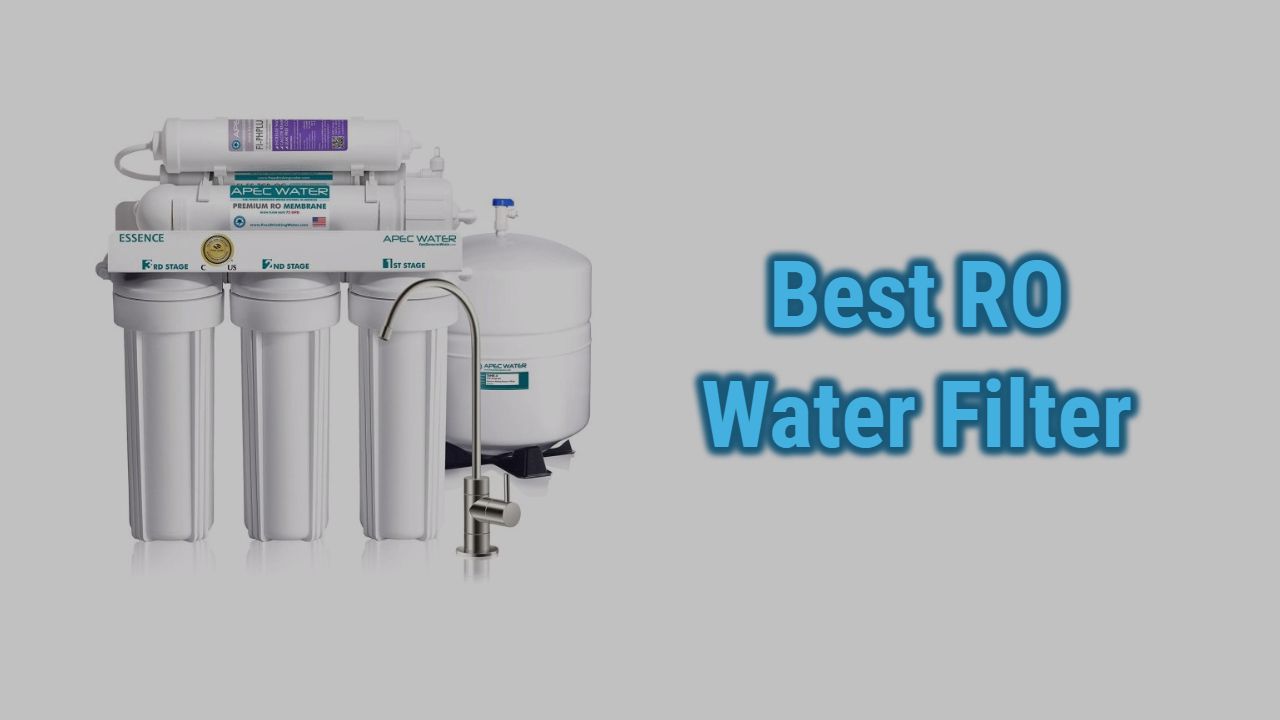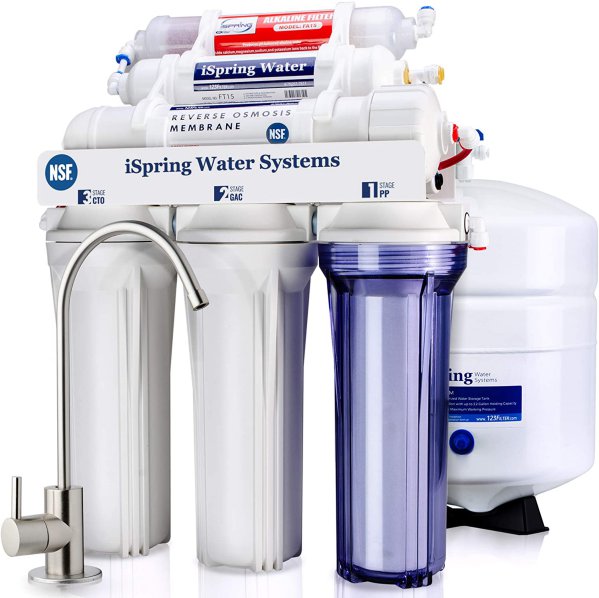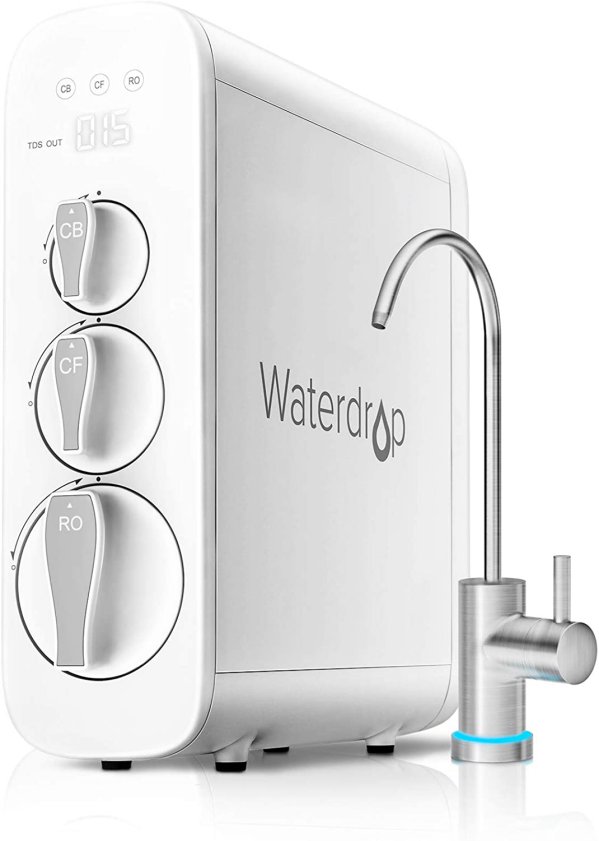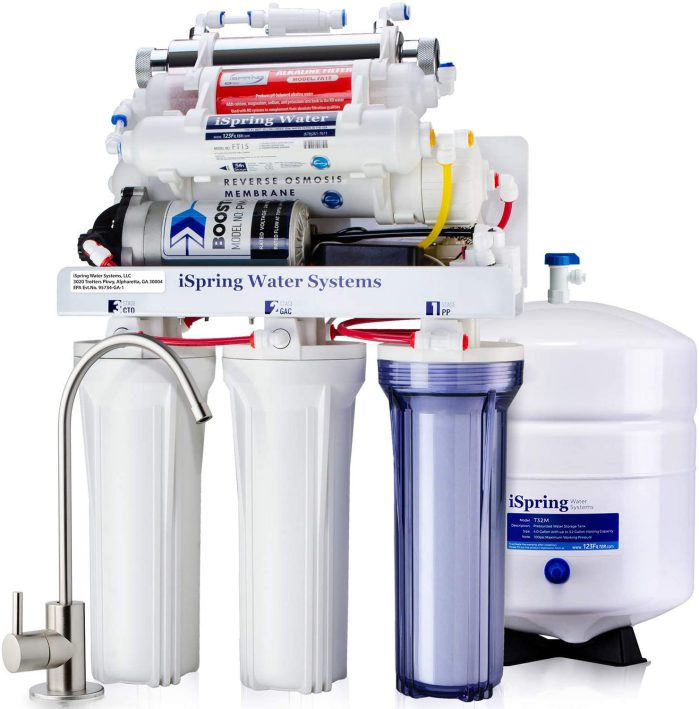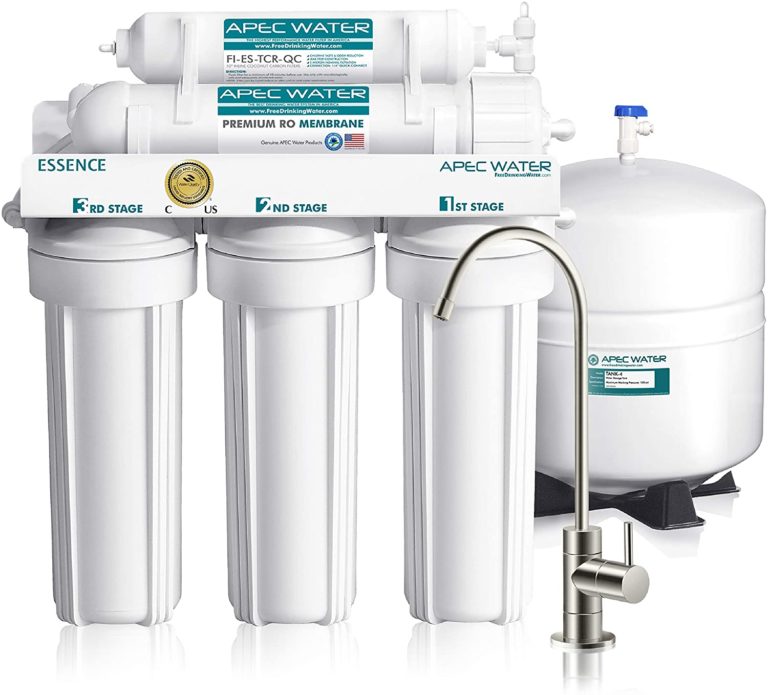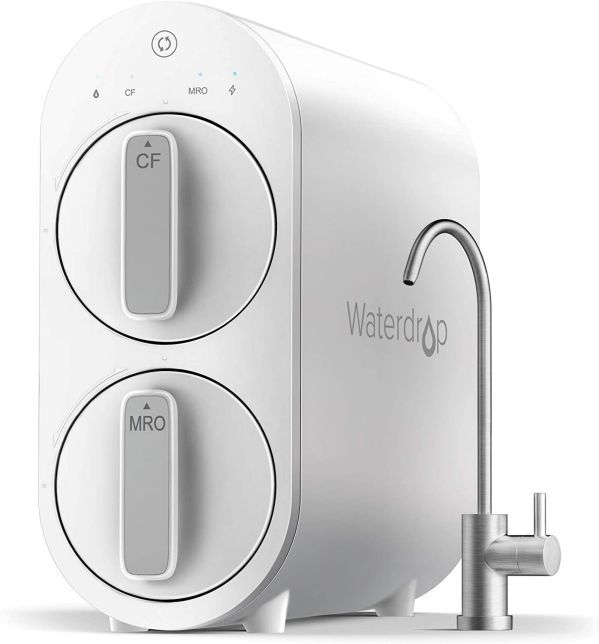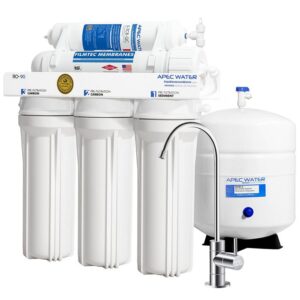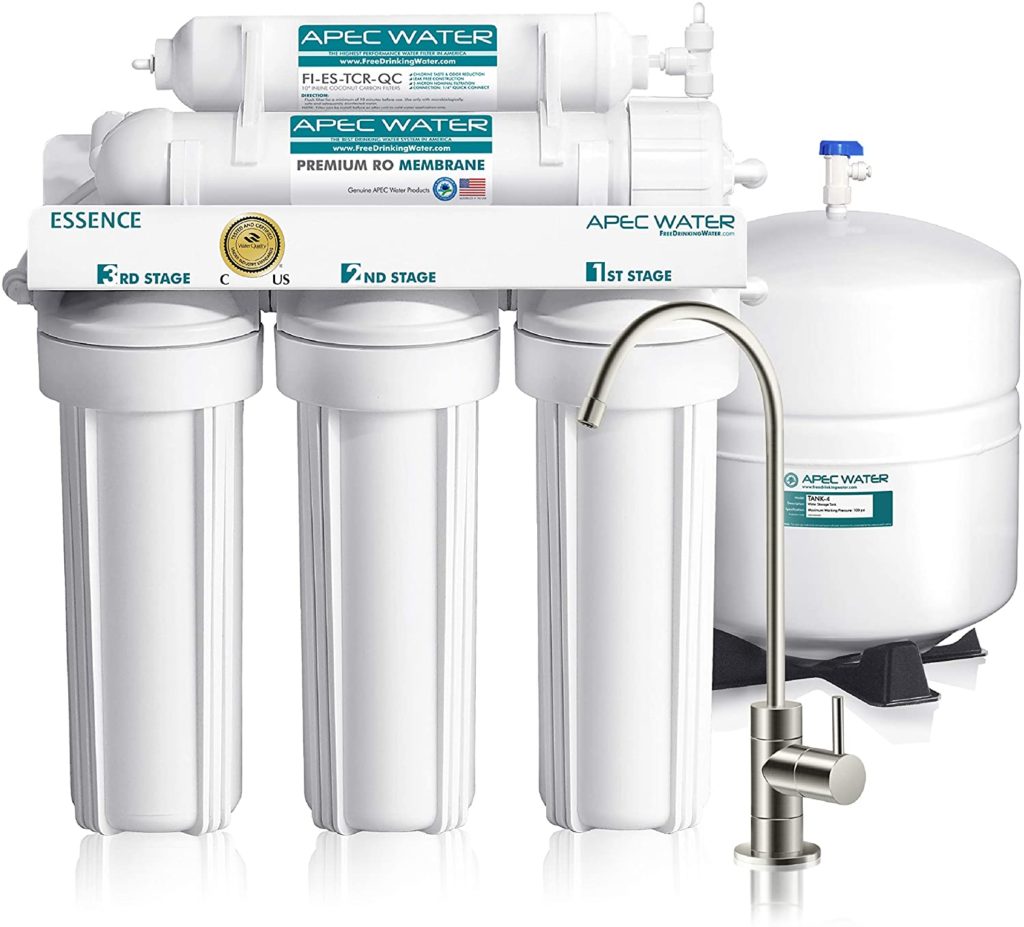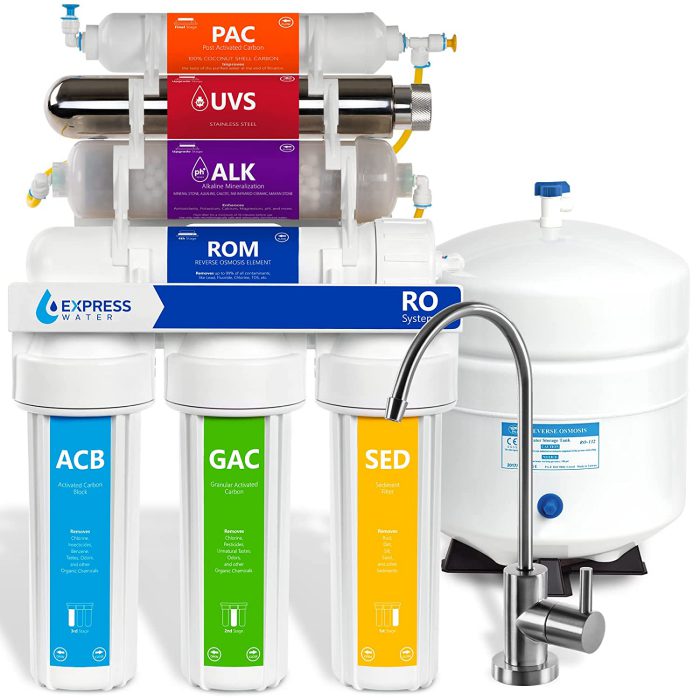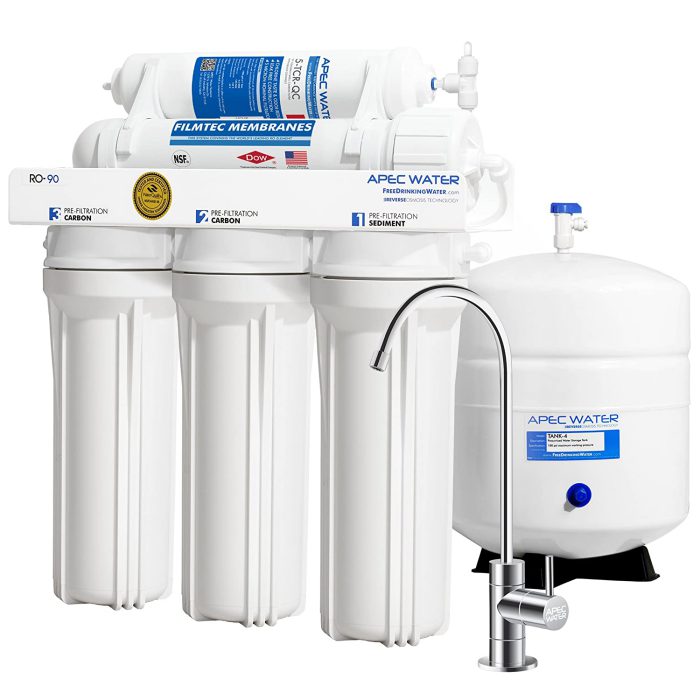The Reverse Osmosis system removes the contaminants from water to make water more drinkable and healthier. There are several systems available in the market to choose from based on their separate uniqueness and consumers’ requirements.
When choosing an RO system for your house you have to take notice of your needs and choose the one that matches your needs the most. Here are a few RO filtration systems which are currently the best in the market. These reviews will help you choose which system is better suitable for your house.
| iSpring RCC7AK (Best Overall)

|
| Waterdrop WD-G3-W (Best Tankless & Lightweight RO System)
        |
| iSpring RCC1UP-AK (Most High-end RO System with UV Filter)
        |
| APEC ROES-50 (Budget Pick)
        |
| EXPRESS WATER ROALKUV10M
        |
| Waterdrop G2 (Another Great Tankless RO FIlter with)
        |
| APEC RO-90
        |
Table of Contents
Best Reverse Osmosis Filter System
1. iSpring RCC7AK 75 GPD 6-Stage Reverse Osmosis System
Let’s see, as someone who’s always been conscious about what I put into my body, finding a water filter that truly delivers on its promises has been a journey.
But my search finally came to an end when I discovered the iSpring RCC7AK Reverse Osmosis water filter. I am glad that I did confront this piece of iSpring.
From the moment I unboxed it, I knew this wasn’t your average water filter. The sleek design and high-quality materials made it clear that iSpring had put a lot of thought into every aspect of this product.
But of course, looks aren’t everything. I was eager to put it to the test and see if it lived up to its reputation.
The wonderful iSpring RCC7AK comes with a capacity of up to 75 gallons per day; it’s perfect for my family’s daily needs. And just to spice things up, the system has a 1:3 water wastage ratio meaning it generates only 1 gallon of wastewater with every 3 gallons of pure water.
Then comes its master versatility, it’s 6-stage advanced filtration system that centered on reverse osmosis technique along with activated carbon and remineralization, which cut short up to 99% of pollutants.
This means that not only does it make the water taste better, but it also makes it healthier for me to drink.
It’s not all about the filters, but I also love how it adds beneficial minerals back into the water. The alkaline remineralization filter adds calcium, magnesium, potassium, and other healthy minerals to the water, giving it a crisp and refreshing taste.
The filter also comes equipped with a helpful indicator that alerts me when it’s time for a filter change, ensuring that I always have access to the cleanest possible water.
The system itself is also compact and doesn’t take up much space in my kitchen. It’s quiet during operation, and I don’t even notice it’s there most of the time. It has excellent sealing with the 4-color coordinated tubing and a leak-free system.
Ultimately, I conclude that iSpring RCC7AK is a real game changer in the market with its stylish and healthy upgrades making all the way perfect charm to the modern kitchen. If you want a high-performing filter, this is the one.
What we like
- Easy to install
- Great taste fresh water
- Leak free system
- Six stage filtrations
- Additional Alkaline filter
- Minimal installation
- Excellent customer support
What we don’t like
- 6 filtration stage makes it heavier
2. Waterdrop G3 NSF Certified 400 GPD Tankless RO Water Filter System
I always kept wandering to get the rightful appliance for my home; when it came to clean and healthy water, all I could think of was millions of RO systems. But I am thrillingly excited to share my amusing experience with the one and only Waterdrop WD-G3P800-W RO system.
I am going to go with my favorite part here; Waterdrop G3 has an impressive 8-stage filtration system. It uses a combination of reverse osmosis, activated carbon, and sediment filters pretty seriously to remove up to 99% of impurities from your water.
This means that you can enjoy clean and pure drinking water that is free from contaminants like chlorine, lead, and fluoride.
Other than that, G3 is a high-quality water filtration system that boasts an impressive set of features like the high flow of fresh and healthy water. With a maximum flow rate of 400 gallons per day, this filter can keep you hydrated all day long.
And with the water wastage ratio of 1:1, you don’t have to worry about the drain and enjoy the water without any slowdowns.
Also, did I mention how great it looks with the all-smart and stylish faucet with the digital display? As per my experience, the G3 is associated with an easy installation process; it’s straightforwardly quickest, taking just an hour.
This is thanks to the filter’s compact and lightweight design, which makes it easy to install in tight spaces.
In addition to its impressive filtration capabilities and easy installation, the Waterdrop WD-G3P800-W RO system water filter also features a sleek and modern design that looks impeccable.
Its LED display shows real-time TDS (total dissolved solids) levels, so you can always be sure that your water is being filtered properly.
With its advanced filtration technology, easy installation, sleek design, and high flow rate, it’s no wonder that so many customers have given it rave reviews. So yeah, it’s a Must-Buy!
What we like
- Auto flushing support
- 8.5-gallon storing tank
- Eight stages of filtering
- Impressive modern design
- Smart LED display
- Maximum flow rate
- No danger of leakage
What we don’t like
- Does not come budget-friendly
3. iSpring RCC1UP-AK 100GPD 7-Stage Reverse Osmosis Drinking Filtration System
Moving to the next, we have a masterpiece, an outstanding creation in the market, the iSpring RCC1UP-AK. A top-performing RO system like this ensures you drink your water safely through the incredibly supportive filtration system.
However, there is so much more the brand iSpring offers in this great tool. They say the first impression is last; the sleek design of the RCC1UP-AK caught my eye at first glance.
It looks modern and would fit in with any contemporary kitchen décor, but majorly the compact size of the Reverse Osmosis system water filter surprised me the most, plus the installation part was surprisingly a breeze.
The RCC1UP-AK’s greatest feature is it is centered on a reverse osmosis water system which is known to be the best method to get rid of all those impurities from water.
The reverse osmosis system removes up to 99% of contaminants, including lead, chlorine, arsenic, fluoride, and more. This is done within the comprehensive seven-stage filtration process.
So goodbye to all the harmful pollutants in water, and let’s toast to the crisp, fresh water with a 1:5 drain ratio.
That’s just not it; the brand iSpring indulges a special skill that will add additional minerals to the drinking water. With a capacity of up to 100 gallons per day, I no longer have to worry about constantly refilling my water bottles.
The filter also has a smart automatic flushing system that helps prolong the life of the filter.
Even with the all-heavenly power, the filter seeks almost minimal maintenance. The replacement filters are reasonably priced, and the LED display lets me know when it’s time to replace them. The filter also has a self-cleaning feature that means extra longevity.
It might be your lucky day because this beauty here, RCC1UP-AK, is a top-of-the-line filtration system that tends to deliver on its promises. With innovation and healthy versatility, this one is worth considering if you want to stay healthy on a decent budget.
What we like
- Seven stage Filter
- Waste less water
- Lead-free Nickel faucet
- Noiseless filtering
- Added effective mineral
- Additional UV filter
- Excellent brand’s support
What we don’t like
- Must be plugged into an outlet
4. APEC ROES-50 5-Stage Ultra Safe Reverse Osmosis Drinking Water Filter System
APEC ROES-50 is another RO filter system one could ever have; with the primary obligation of making a straight way to remove household water from impurities, this exclusive APEC’s piece does the job pretty magnificently.
While comparing the system in the market, there are numerous advanced features that make them superior to the ordinary.
First off, let’s talk about technology. This system boasts a top-notch 5-stage filtration process, including sediment, carbon block, and reverse osmosis filters. The result? Pure, clean water that tastes absolutely delicious.
Plus, with a capacity of up to 50 gallons per day, this system can easily keep up with my daily water needs.
Apart from the supreme filtration system, the ROES-50 is impressively easiest to use. I cannot emphasize enough how crisp and refreshing the water tastes after passing through the ROES-50.
Also, Installation was a breeze with the true leak-free fitting protection, and the quick-connect fittings made setting up the system a snap. Once it was up and running, I was amazed at how little maintenance was required; This is not something you see every day.
The filters only need to be changed once a year or every 2,000 gallons of water, making it a low-maintenance and cost-effective solution.
And at last, I particularly appreciate the ROES-50 user-friendly design, which includes a clear, easy-to-read display and a sleek, compact design that doesn’t take up too much space in my home.
On top of its durable construction and long-lasting filters, I am confident that this system will serve me well for years to come.
ROES-50 RO water filter is a savior to anyone who needs a low-maintenance, designed filter at a reasonable price. If you are that guy who has an eye for a high-quality, easy-to-use, and effective water filtration system, this is an ideal fit.
What we like
- Heavy duty durability
- Easy installations
- Pocket-friendly cost
- Five stage filter
- Ultra-Pure water
- Long lasting filters
- Two-year warranty
What we don’t like
- Flow rate could be better
5. EXPRESS WATER ROALKUV10M UV Reverse Osmosis Water Filtration System
Say goodbye to the harmful substance in your everyday glass of water; it’s time to start living healthily with this advanced ROALKUV10M, a wonderful reverse osmosis system.
An exceptionally innovative creation of the Expresswater, which deals with all the impurities of your water to ensure refreshing hydration throughout the day, now without much expense either
If the ROALKUV10M is counted as the best reverse osmosis water filter, there might be something exclusive and special about it. I believe the primary feature of filtering is the key.
This RO filter uses an 11-stage filtration process to remove all the contaminants from your water, including chlorine, lead, arsenic, fluoride, and more.
One of the standout features of this system is its UV purification process. With the 11-stage filters removing impurities, the system has a powerful weapon of UV light that destroys 99.99% of bacteria and viruses.
As someone who is concerned about the safety of my drinking water, this added layer of protection gives me peace of mind. However, the versatility of ROALKUV10M doesn’t end there; after the impurities removal, there comes the mineralization stage.
The system makes sure to add back essential minerals like the positive calcium, magnesium, and others to purified water, so now I can get all the necessary nutrients from drinking water.
The system supports a 4-gallon water storage capacity and 0.8 gallons per minute or 100-gallon per day flow rate for decent dispensing of water.
Installation was surprisingly easy, even for someone like me who isn’t particularly handy. The system comes with all the necessary parts and clear instructions that make the process straightforward with all the compact and stylish design.
Whether you are a health enthusiast or a busy individual from a comprehensive family, this super effective way to improve your water quality is going to make things adventurous in your daily do’s. Up to your expectation, I believe ROALKUV10M is the ultimate key.
What we like
- 11 Stages of advanced filtering
- Effective Alkaline Mineralization
- Extra UV purification
- Space-saving under-sink design
- Leak stop detector
- One year after purchase service
- Reasonably economical
What we don’t like
- Storage tank capacity is low
6. Waterdrop G2 7-Stage Tankless Reverse Osmosis Water Filter System
Valuing both quality and convenience has always been an easy task, especially when it comes to choosing the best reverse osmosis system for your home. I prefer the best, which is why I picked up the
Waterdrop created WD-G2-W to enhance my family’s hydration experience by assuring its purity; boy WD-G2-W doesn’t disappoint in my very purpose.
One of the standout features of the WD-G2-W is its compact size. This system is perfect for smaller households or those with limited space, as it can be easily mounted under your sink or even on a nearby wall.
But don’t let its size fool you – this system has a robust filtration capacity, able to produce up to 400 gallons of purified water per day.
And there is no match in terms of filtering toxicity from water; with a 7-stage filtration process, I can taste the difference in the water immediately. It’s crisp, clean, and refreshing, without any of the strange aftertastes that can come from other filtration systems.
Thanks to its advanced reverse osmosis technology. And no worries about water waste, either the exclusive 1:1 ratio rate that signifies one gallon of water waste per one gallon of water saving water by 300%.
Let’s talk about maintenance; I believe I have not confronted any other low maintenance rate like this one; WD-G2-W can surely be counted for its cost-effectiveness.
With a filter lifespan of up to 12 months, I no longer need to purchase expensive bottled water or frequent filter replacements, saving me both time and money in the long run.
The system includes helpful indicators that let you know when it’s time to replace the filters, and the quick-change design means that the process is quick and painless.
Diving into the outer structure, I must say I am pretty amused with the system’s tankless innovative design with a compact approach.
The technical features are sharp, the easy handling is impressive, and the filtration result is just fantastic, so what could a guy want more? If you need a high performer on a reasonable budget, don’t settle for anything less than this WD-G2-W.
What we like
- Seven stage filtrations
- Magnificent water flow
- Low drain ratio
- Compact footprint
- Simpler 30 min installation
- Minimal maintenance
What we don’t like
- Requires power supply
7. APEC RO-90 90 GPD Reverse Osmosis Drinking Water Filter System
For a long while, I have been passionate about healthy living, which is why I always stay on the lookout for products that can help me achieve my wellness goals.
That’s why I was excited to try the APEC RO-90 Reverse Osmosis water filter. I’ve been using this system for several months now, and I’m happy to report that it has exceeded my expectations.
This state-of-the-art system boasts a powerful 5-stage filtration process, which ensures that every drop of water that passes through is stripped of all contaminants, such as chlorine, lead, arsenic, fluoride, and even bacteria and viruses!
Fresh water on the go. The filtration process removes up to 99% of contaminants granting a heavenly taste to water.
Just when I thought it would be enough, I came across the RO-90 potentiality. With a production rate of up to 90 gallons per day, this system is perfect for larger households or small businesses.
And the best part? It does all this while using minimal energy, thanks to its energy-saving design. Also, get excited to live luxuriously because the RO-90 tank can hold up to four gallons of water, so you don’t have to refill it frequently.
What makes RO-90 different from the competition is the attention to detail. The user-friendly system is designed with a leak-free quick, connect fitting and high-quality tubing, ensuring your water stays pure and your system stays secure.
And with a sleek and compact design, this filter is a stylish addition to any kitchen.
One thing I particularly appreciate about the RO-90 is its durability. The system is constructed from high-quality materials, which ensures it will last for years to come. The designer faucets and filters are also long-lasting, with a lifespan of up to twelve months.
In the final few words, RO-90 is a real diamond in the world of purification. The efficiency, technology, and ease can compile any water lover out there. Invest in this G2 filter and enjoy a lifetime of clean and healthy water.
What we like
- Five stage filtrations
- True Leak-free fitting
- Designer faucet
- Durable, long-lasting filters
- Money saver tag
- Installation is Breeze
- 2-year manufacturer warranty
What we don’t like
- Only four-gallon capacity
What is Reverse Osmosis?
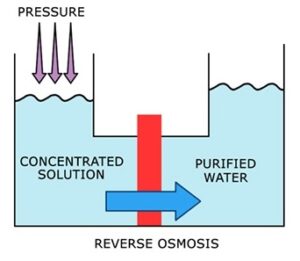

Reverse Osmosis is a process used to remove impurities from the water by pushing them through the permeate membrane. When the water passes through the very thin layers of the membrane, it filters out contaminations.
This process removes many dissolved contaminations and chemicals while pushing the water through the very thin layer of permeate membrane. The permeate membrane filters out all the impurities which are larger than the water molecules.
Reverse Osmosis is used to purify the water from more than 1000 contaminations, eliminating all the odors, gases, and TDS from the water.
How does the Reverse Osmosis System work?
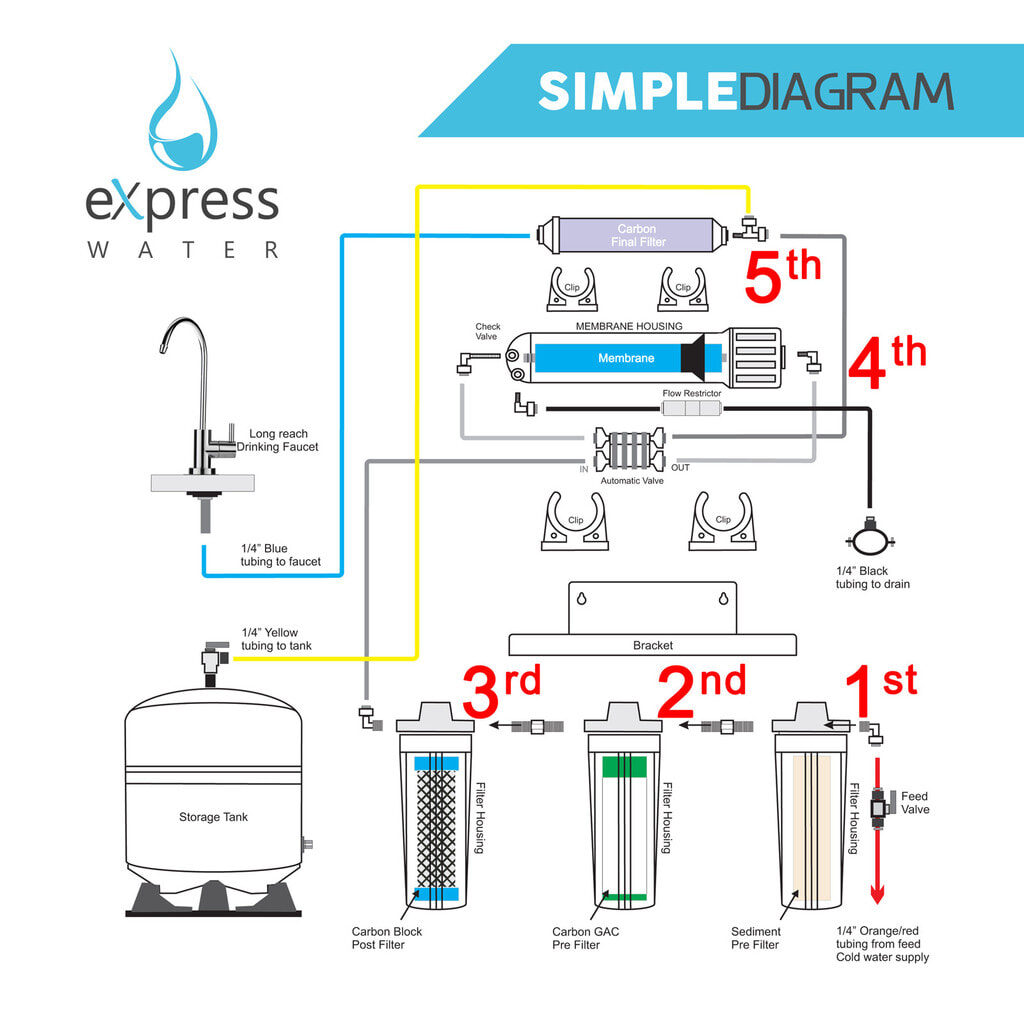

The Reverse Osmosis system filters out any contaminants like chloride, dust, viruses, etc from water.
This system consists of the main 3 stages of filtration to provide you with healthy drinking water. These three main stages consist of pre-filters, RO membranes, and post-filters.
Water flows through pre-filters to remove the large contaminants, sand, and dust before going into the membrane.
In the next stage, the water passes through the thin layers of the RO membrane, which removes all the particles that are larger than 000.1 microns. Basically eliminating all the particles except for water.
In the post-filtering, the purified water passes through a carbon-based layer that removes any bad taste and odor from the water, making the water contaminants-free and pure.
Several systems follow these 3 main purification filtration processes in 7 stages. Let us see how the Reverse Osmosis system works step-by-step in 7 stages.
- Sediment Filter– Water passes through the sediment filter and removes large particles like rust, dust, sand, etc. so that the water can be sent through a permeate filter.
- Carbon Filter– This filter eliminates chemicals like chlorine from the water making it safe to pass through permeate membranes.
- Carbon Block Filter– The water passes through the carbon block filter to remove all the pesticides, fertilizers, and insects which are too small to spot with human eyes.
- Reverse Osmosis Membrane– This is the main stage of the Reverse Osmosis system. The Reverse Osmosis membrane has small holes, when the water passes through this membrane it removes all the molecules which are larger than 000.1 microns.
- Removal of Impure Water– In this stage, the impure water is discarded by the system via a separate pipe so that it doesn’t enter the next filter.
- Remineralization– This process is skipped in some of the Reverse Osmosis systems. Remineralization adds extra minerals back into the water, these minerals can be calcium, potassium, etc. Not only does it make the water healthy but it makes the water taste better.
- UV Light Filters– This filter is optional. Ultraviolet light removes all the microorganisms which somehow manage to pass through the permeate membrane and gives you highly purified water.
There are many other optional customizations you can choose for your Reverse Osmosis system.


- Some of the systems come with a water storage tank. Without the water tank, you will get the water filtered in real-time. But if you want to get a system that occupies less space in your home, then you should opt for the tankless system.
- Remineralization filters are also customizable in some systems. You can choose the minerals you want to have in your water and you can get a remineralization filter based on your needs.
- Some of the systems come with high-pressure pumps to have fast-flowing water on your tap.
- There are some systems that come with lead-free faucets if you do not wish to use the same faucet in your sink. Using the lead-free faucet will reduce the risk of contamination and chemicals coming into the water because of the surface of the faucet.
What to look for when buying the Reverse Osmosis System?
There are several points that can help in choosing which RO system is best for your requirement. It is necessary to first identify your requirements with the Reverse Osmosis System.


Firstly you will have to find answers to the questions like,
The RO System with or without Tank
It is necessary to identify if you need an RO system that occupies less space in your home. Several systems come without the tank and are compact in design. If you want to purchase a system with a tank, it is necessary to make sure what kind of tank size you will need. These tanks come in capacity from 3 gallons to 14 gallons.
Installation
First, you will need to figure out if you wish to buy a system that needs a plumber to make it work or, do you want something like a do-it-yourself (DIY) installation. Based on this you can choose a system with easy installation and customer support.
Customizable system
Several brands offer customizable systems via which you can get a system that meets your needs perfectly. While choosing a customizable system it is necessary to identify the factors like water source, filters, space, etc
Your needs for the system
Before choosing a system, it is necessary to decide for what purposes do you want to use the Reverse Osmosis system. Do you want the system for drinking? Attaching it to the refrigerator? For your aquarium?, or Do you want a system just for your kitchen or your whole home?
After identifying answers to these questions, there are several other points that should be considered before buying the Reverse Osmosis System, let’s see what are those:
The Lifespan of Filters and Filter Stages
When it comes to filters there are certain different filters with different lifespans with each system. You have to choose a system with filters, which has more lifespan and capacity. There are several filters that come with a limited lifespan becoming a reason for continuous expenses on the filters.
The stages of the filter identify the purification of the water. Any system with more than 6 to 7 stages is an idle system to choose to get highly purified water. There are certain systems that come at a reasonably cheap price but filter change becomes a hassle. Before buying a system you will have to check on the process of filter change and the cost of these replacement filters.
Water wastage
So many RO systems have a high ratio of water waste to purified water. When you choose a system with less water waste, you decrease your water bill significantly. Wastewater is one of the setbacks of the Reverse Osmosis System. There are systems that produce wastewater up to 25 gallons to purify 1 gallon of water. This wastewater contains a high amount of contaminants making the water useless. So, it is necessary to look for a system that has a minimum ratio of water waste to purified water.
The Flow of the water
Even the most expensive RO filters have low water flow compared to the non-RO filters. Some systems fill your cup in 12 seconds whereas some systems take more than a minute to fill up your cup. The reason for low flows can be because of different reasons like water source, flow pump, etc.
Capacity of the system
Before you choose the water filter to install in your whole house, you will have to identify the need for water quantity in a day. Some systems have the capacity of producing 75-90 gallons of pure water in a day whereas some systems have the capacity to produce 12 gallons of pure water in a day. Identify your usage capacity and choose a system that matches it perfectly.
Remineralization
The Reverse Osmosis system purifies water of any impurities, but sometimes some consumers face health challenges due to demineralized water. If you are keen on having minerals in your water always choose a system that uses mineral filters to remineralize your water.
Size of the System
There are several sizes available in the market for RO systems. Some systems occupy very little space whereas some RO systems fill up your under-sink space with their set-up. If you are looking for a system that requires less space but still works in seven stages of purification, you will have to choose a system with advanced technology. Sometimes the systems which require less space are made with advanced technology costs higher than any regular systems.
Different components of the Reverse Osmosis system
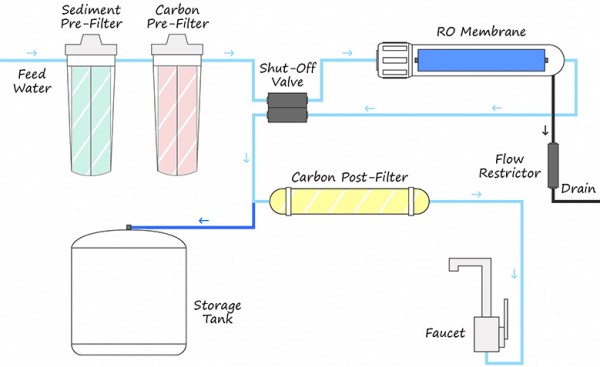

Pre-filters
Pre-filtering is the first and important stage of the reverse osmosis system. Pre-filters remove large contaminants from water before the water enters the RO membrane. Without the pre-filter, the lifespan of the RO membrane can be really short.
RO membrane
When the water passes through the RO membrane it removes all the chemicals, viruses, bacteria, etc. RO membrane generally removes contaminants that are larger than 0.0001 microns.
Post-filters
Post-filters are the filters situated between your storage tank and your tap. It removes carbon or any other substances in the water ensuring better-tasting pure water.
Storage tank
Certain RO systems have storage tanks among their components. Once the water is purified in the RO system, the purified water is stored in this tank. Some people choose not to install storage tank in order to save space.
Shut-off Valve
Without the shut-off valve, your kitchen would probably flood. A shut-off valve is usually automatic, making sure to stop the water from filling inside the storage tank once it’s full.
Faucet
Most of the companies producing RO systems suggest switching your old faucet with a new one. Switching your current faucet with the one which comes with the system can eliminate the risk of lead in your purified water.
UV light
UV light is usually considered one of the most important post-filters. UV light kills remaining microorganisms that somehow found their way through the RO membrane.
Water pressure pump
If the input of the water is low then the output is going to a low water flow. Installing a water pump helps in increasing the water flow hence water filtering capacity.
Permeate pump
A Non-electric permeate pump ensures that the water wastage is less. Making the water waste as minimal as possible
Electric pump
Like the permeate pump, an electric pump ensures that the minimum amount goes down the drain. It has the same work as the permeate pump, the only difference is that the permeate pump is non-electric.
Advantages and Disadvantages of Reverse Osmosis System
A reverse Osmosis System doesn’t come cheap. Now the main question is if the Reverse Osmosis system is really worth spending your money on it.
Let us see the pros and cons of the RO System.
Advantages
Easy Installation
Almost all RO systems come with an instructional manual and instructional videos to help you set up the system in your kitchen or basement.
Gives amazingly purified water
The RO system removes 99.9% of the water contaminants and chemicals in the water, giving you odorless and tasty purified water.
Less expensive than bottled water in the long run
Some RO filters cost a fortune while some are way cheaper. RO systems are a one-time investment, after that, you will just need to change filters after their expiry. Overall in a long span of time, the cost of having an RO system is less than purchasing bottled water.
Easy access to mineral water at all time
If you purchase an RO system with remineralization filters, you can have healthy and pure mineral water at all times in your tap.
Disadvantages
Expensive than a regular filter
The Reverse Osmosis filter costs more than the regular filter.
Requires Filter change every few months
While the system gives purified water, it also requires timely filter changes which can be a little frustrating for people.
Removes minerals from water
If there’s no remineralization filter installed in the system, the purified water will have no minerals at all.
Water Wastage
One biggest drawback of the RO system is water waste. The lowest water waste ratio in some RO systems is 1:1 to 1:3 in the latest systems.
Installation and Maintenance of the Reverse Osmosis Filtration System
Some people prefer to hire a plumber for the installation of the system although it is fairly easy to install by yourself, so many companies provide instruction manuals and instructional videos to make the installation hassle-free and quick.


The installation process takes up to 1-2 hours. Here are the steps to guide you for installation.
Choosing the space for installation.
First, you will have to decide on the place you want to install the system. Most of the time people install the system under the kitchen sink to get purified water from the kitchen sink tap. You can also put it in your basement and get the pipe through the floor to tap.
Disconnect the current water faucet and turn off the cold water line.
Before you begin to install your system, make sure to disconnect the cold water line. Also, do not forget to disconnect the water pipe which is connected to your tap.
Connect the system with a waterline.
After disconnecting the waterline with your sink’s tap, now it’s time to connect the system with the waterline.
Connect the drain line.
Once you are done connecting the waterline with the system, you would want to connect your drain line with your waste pipe. Make sure to fasten it properly so it won’t leak.
Install the faucet which came with the system.
It is advised to use the tap which came with the system. Usually, the tap which comes with the system is lead-free, connecting your system to the old tap does not guarantee clean and pure water. You can remove your current tap and install the new faucet in its place or you can drill a new hole to install the new process.
Set the system in place.
After making sure that the previous steps are followed perfectly, set the system in place of your desired location.
Install the tank.
If your system includes the water tank, connect the tank to the filters and the tank’s line to the tap. In some systems the water tank comes connected to the filters, when it does, make sure that the lines are tightly connected and connect the line of the tank to the water faucet.
Plug the system.
If your system works on electricity make sure to plug in your system to the electric outlet after you are done installing the system.
System check.
Once you’re done turn on the valve slowly and check if any pipe or line is leaking, if anything leaks, secure those lines.
Flush the water tank after installation.
Almost every Reverse Osmosis system provider advises filling and emptying the tank after installing it. This can be different with each system. For some systems, it is advised to flush the tank more than once.
Check the manual guide for your system. If you have a tankless system, it is advised to let the water flow from the tap as long as it is advised in the system’s manual instructions.
Maintenance points to consider after installing the system
You will have to maintain changing the filters from time to time based on your water source and usage. On average these filters need to be changed every 6 months to 12 months. The RO membrane filters should be replaced every 2 to 3 years.
Some of the system models come with transparent filter cases, you would just have to keep an eye on the need for filter changes at intervals and change the filter when required.
Some faucets come with LED light indicators when the system needs attention or filter change. Make sure to keep a watch on the colors of the tap to change the filters at the required time.
Frequently Asked Questions (FAQ)
Q. How does the Reverse Osmosis System work?
The water goes through the sediment filter and removes the large particles like dust and sand from the water, then the water goes through the RO membrane to remove the chemicals, viruses, and insecticides, which are larger than 0.0001 microns ensuring the water is purified.
After purifying through the RO membrane, water goes through the carbon filter removing any microorganisms, odor, or taste from the water. Some systems have remineralization filters that add minerals into the water before it comes out from your tap.
Q. How long does the Reverse Osmosis system last after purchasing?
The Reverse Osmosis system lasts for a very long time if you change the filters when needed. Filters are the only thing you will have to keep changing, the whole system lasts a lifetime.
Q. How much does it cost to install the Reverse Osmosis system?
It costs nothing if you install it yourself and some systems come with instruction manuals and instruction videos to help you install it. There are some companies that also provide technical support to assist you when you are installing the system. If you choose to hire a plumber to install the system, it would cost you around $100 to $350.
Q. What is better? Distilled water or Reverse Osmosis water?
Distilled water does not remove all the pesticides and chloride from the water as efficiently as Reverse Osmosis water. If compared, RO water is purer from any contaminants.
Q. How much water waste does the Reverse Osmosis system produce?
This is a drawback of the RO system, This system wastes about 4 gallons of water with every 1 gallon purified. Although, there are several systems available that have a lower water-waste ratio.
Related Article:
Best Tankless Water Heaters of 2024 | Comparison & Reviews
Best Water Softeners | Reviews & Buying Guide
Best Countertop Water Filters of 2024 | Reviews & Comparison Chart
Reverse Osmosis System Vs Water Softener | Explained
APEC ROES-50 5-Stage Reverse Osmosis (RO) Water Filter Review
